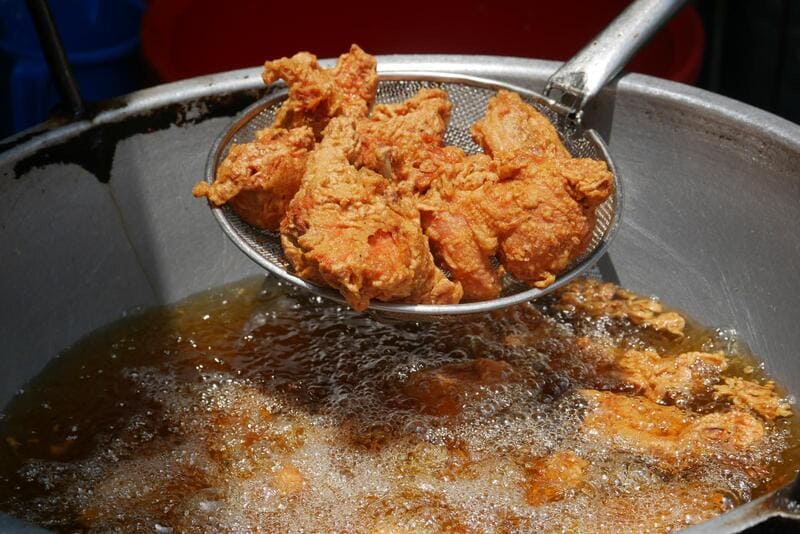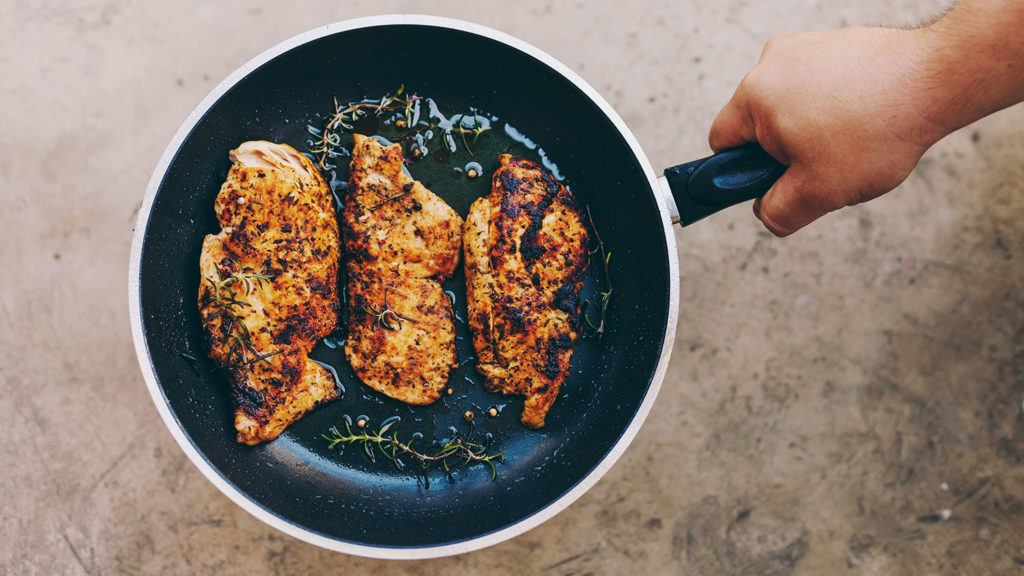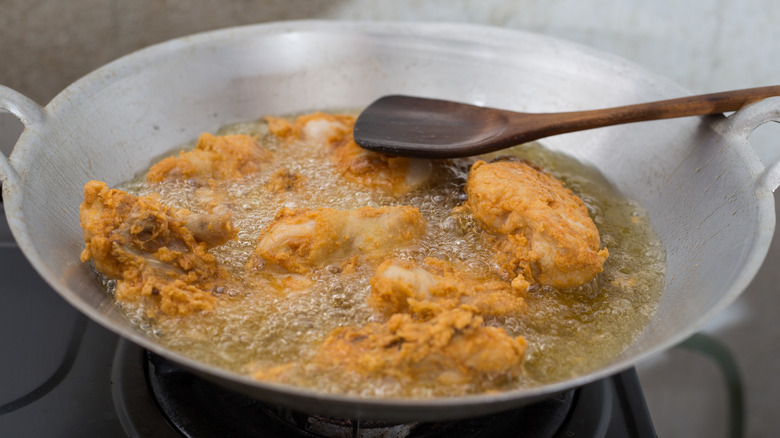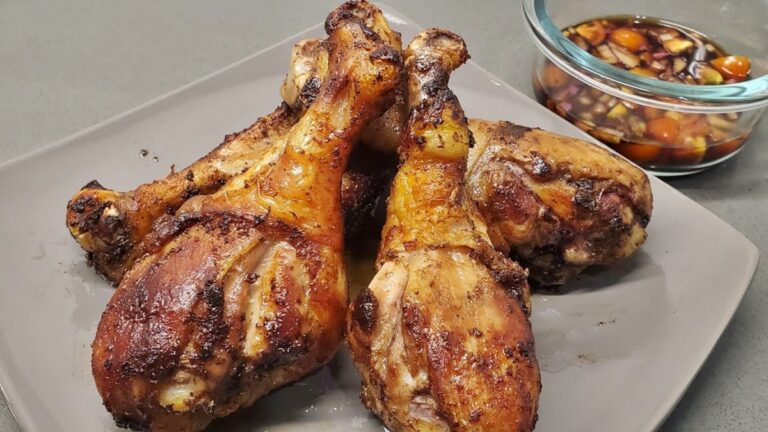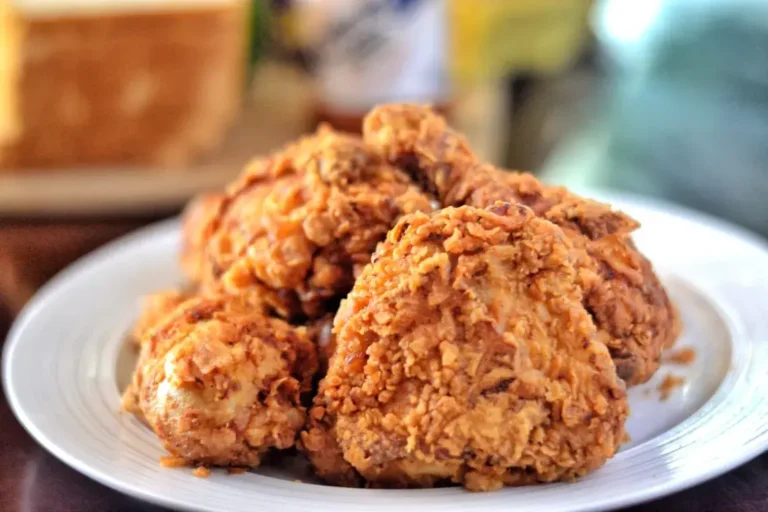Can You Fry Chicken in Olive Oil ?
Have you ever wondered if it’s possible to fry chicken in olive oil? It’s a theory that has been debated among cooking enthusiasts and health-conscious individuals alike.
Some claim that the health benefits of olive oil make it an ideal choice for frying, while others argue that its low smoke point may result in a less-than-desirable outcome.
But is there a definitive answer to this culinary conundrum? In this Can You Fry Chicken in Olive Oil? discussion, we will explore the science behind frying chicken in olive oil, the potential effects of high heat on this versatile oil, and whether there are alternative methods to achieve that coveted crispy texture.
So, let’s dive into the sizzling world of frying chicken in olive oil and find out if it’s a match made in culinary heaven.
Contents
- 1 Key Takeaways
- 2 Health Benefits of Olive Oil
- 3 Smoke Point of Olive Oil
- 4 Effects of High Heat on Olive Oil
- 5 How to Properly Fry Chicken
- 6 Alternatives to Frying Chicken in Olive Oil
- 7 Tips for Achieving Crispy Fried Chicken
- 8 Conclusion: Can You Fry Chicken in Olive Oil?
- 9 Frequently Asked Questions
- 9.1 How Many Calories Are in Fried Chicken Cooked in Olive Oil?
- 9.2 Can I Reuse the Olive Oil After Frying Chicken?
- 9.3 Does Frying Chicken in Olive Oil Affect Its Nutritional Value?
- 9.4 Can I Use Extra Virgin Olive Oil for Frying Chicken?
- 9.5 What Are the Best Spices or Marinades to Use When Frying Chicken in Olive Oil?
- 10 Conclusion – Can You Fry Chicken in Olive Oil ?
Key Takeaways
- Olive oil has different smoke points depending on its quality and type, with extra virgin olive oil having a lower smoke point compared to refined olive oil.
- Frying chicken with olive oil requires choosing an oil with a high smoke point to prevent the production of harmful compounds.
- High heat can affect the quality and taste of olive oil, leading to rancid flavors and potential health risks.
- Alternatives to frying chicken in olive oil include air frying or using oils like peanut oil or canola oil for variety in flavors and textures.
Health Benefits of Olive Oil
When it comes to the health benefits of olive oil, you can’t go wrong with incorporating this nutritious ingredient into your diet. Olive oil is widely recognized as one of the healthiest cooking oils available, and its numerous health benefits are backed by scientific research.
One of the primary reasons olive oil is considered healthy is its high content of monounsaturated fats. These fats are known to promote heart health by reducing bad cholesterol levels and increasing good cholesterol levels. Additionally, olive oil is rich in antioxidants, such as vitamin E and polyphenols, which protect the body against oxidative stress and inflammation.
Incorporating olive oil into your cooking techniques offers a range of culinary uses. It’s a versatile ingredient that can be used for sautéing, roasting, grilling, and even frying. Its high smoke point makes it suitable for high-heat cooking methods, such as stir-frying. The unique flavor of olive oil also enhances the taste of dishes, adding a subtle fruity and peppery note.
Smoke Point of Olive Oil
When it comes to frying with olive oil, one important factor to consider is its smoke point.
The smoke point refers to the temperature at which the oil starts to emit smoke and break down, resulting in the production of harmful compounds.
Different types of olive oil have varying smoke points, with extra virgin olive oil having a lower smoke point compared to refined olive oil.
It’s crucial to choose an olive oil with a high smoke point for frying to avoid the release of toxic substances and maintain the health benefits associated with olive oil consumption.
Olive Oil Smoke Point
The smoke point of olive oil, a crucial factor in determining its suitability for frying chicken, can vary depending on the quality and type of olive oil. When choosing an olive oil for frying, it is important to consider its smoke point, which is the temperature at which the oil starts to break down and produce smoke. This breakdown can result in the formation of harmful compounds and a burnt taste in the food.
Different types of olive oil have different smoke points. Extra virgin olive oil, which is made from the first pressing of olives, has a lower smoke point compared to refined olive oil. The table below provides an overview of the smoke points of various types of olive oil:
| Olive Oil Type | Smoke Point (°F) |
|---|---|
| Extra Virgin | 320-375 |
| Virgin | 420 |
| Pure | 425-470 |
| Light | 470-485 |
| Refined | 465-470 |
To ensure the best results when frying chicken, it is recommended to use an olive oil with a high smoke point, such as refined or light olive oil. This will help maintain the integrity and flavor of the oil while achieving a crispy and delicious fried chicken.
Frying With Olive Oil
To achieve optimal results when frying with olive oil, it’s crucial to consider the smoke point of the oil you’re using. The smoke point refers to the temperature at which the oil starts to break down and release smoke. When olive oil reaches its smoke point, it can produce harmful compounds that affect both the taste and the healthiness of the food.
Therefore, it’s important to choose an olive oil with a high smoke point for frying. Extra virgin olive oil, although popular for its flavor, has a relatively low smoke point and isn’t ideal for frying. Instead, refined olive oil or light olive oil, which have higher smoke points, are better options for frying techniques.
Health Benefits of Olive Oil
Have you ever wondered about the health benefits of olive oil and how its smoke point affects its nutritional value?
Olive oil, particularly extra virgin olive oil, has long been recognized for its numerous health benefits. It’s a staple in the Mediterranean diet, which is known for its positive impact on heart health and overall well-being.
When it comes to cooking, using olive oil has its advantages. Unlike other oils, olive oil has a higher smoke point, which means it can be heated to higher temperatures without breaking down and releasing harmful compounds. This makes it a great choice for frying and sautéing.
Furthermore, olive oil is rich in monounsaturated fats, which are considered heart-healthy fats that can help lower bad cholesterol levels. Incorporating olive oil into your cooking can be a simple and beneficial way to enhance the nutritional value of your meals.
Effects of High Heat on Olive Oil
When olive oil is heated to high temperatures, it undergoes chemical changes that can affect its quality and taste.
One important factor to consider is the smoke point of olive oil, which is the temperature at which it starts to smoke and break down. When olive oil reaches its smoke point, it can release harmful compounds and develop a burnt taste.
Additionally, high heat can accelerate the oxidation of olive oil, leading to the formation of rancid flavors and potential health risks.
Olive Oil Smoke Point
The smoke point of olive oil, which refers to the temperature at which it starts to break down and produce smoke, is a crucial factor to consider when frying chicken. Understanding the smoke point of olive oil can help you achieve the perfect crispy, golden-brown crust on your chicken.
Here are four important things to know about the smoke point of olive oil:
-
Different types of olive oil have different smoke points. Extra virgin olive oil, which is the highest quality and least processed, has a lower smoke point compared to refined olive oil.
-
The smoke point of olive oil can range from 325°F to 468°F (163°C to 242°C), depending on the type and quality of the oil.
-
Heating olive oil beyond its smoke point can lead to the production of harmful compounds and a burnt taste in your food.
-
To preserve the quality of your olive oil and extend its shelf life, store it in a cool, dark place away from direct sunlight and heat sources.
Knowing the smoke point of olive oil can help you make informed decisions when cooking and ensure that your fried chicken turns out delicious every time.
Oxidation and Rancidity
Oxidation and rancidity are common effects of subjecting olive oil to high heat during the frying process. Olive oil contains unsaturated fats, which are prone to oxidation when exposed to heat and oxygen. This oxidation process leads to the production of free radicals and the breakdown of the oil’s molecular structure. As a result, the oil becomes rancid, developing an unpleasant taste and odor. To prevent oxidation effects and maintain the quality of the oil, it is important to take certain precautions. First, choose an olive oil with a high smoke point to minimize exposure to high heat. Second, avoid reusing the oil multiple times, as it increases the likelihood of oxidation. Lastly, store the oil in a cool, dark place to protect it from light and oxygen.
Here is a table that summarizes the effects of oxidation and rancidity on olive oil:
| Effects of Oxidation and Rancidity on Olive Oil |
|---|
| Unpleasant taste and odor |
| Decreased nutritional value |
| Potential health risks |
How to Properly Fry Chicken
To fry chicken properly, you should begin by selecting a suitable cooking oil, such as olive oil. Here are four key steps to ensure you achieve the best results:
-
Preheat the oil: Before adding the chicken, make sure the oil reaches the right temperature. This is crucial to ensure the chicken cooks evenly and absorbs less oil. Use a deep-fry thermometer to monitor the temperature, aiming for around 350°F (175°C).
-
Use a deep, heavy-bottomed pan: A deep pan with high sides will prevent oil splatters and spills, while a heavy-bottomed pan will distribute heat evenly, preventing hot spots and ensuring a crispy, golden exterior.
-
Don’t overcrowd the pan: For optimal frying, cook the chicken in small batches. Overcrowding the pan will lower the oil’s temperature, resulting in greasy, soggy chicken. Allow enough space between the pieces for proper heat circulation.
-
Drain excess oil: After frying, place the cooked chicken on a wire rack or paper towels to drain any excess oil. This step helps remove any residual oil and prevents the chicken from becoming greasy.
Alternatives to Frying Chicken in Olive Oil
Consider other cooking oils as alternatives to frying chicken in olive oil if you’re looking for different flavors and textures. While olive oil is a popular choice for frying chicken, there are several other options that can provide unique and delicious results.
One alternative method you can try is air frying. This technique uses hot air circulation to cook the chicken, resulting in a crispy exterior and juicy interior without the need for excessive oil. It’s a healthier option as it requires significantly less oil compared to traditional deep frying.
If you prefer the taste and texture of deep-fried chicken, there are also other oils that work well for this cooking method. Peanut oil, for example, has a high smoke point and a neutral flavor, making it a popular choice for deep frying. Its high smoke point means that it can withstand the high temperatures required for deep frying without breaking down and affecting the taste of the chicken. Another option is canola oil, which also has a high smoke point and a mild flavor.
When choosing an alternative oil for frying chicken, it’s important to consider the smoke point, flavor, and health benefits of each option. By exploring different cooking oils, you can create a variety of flavors and textures that will satisfy your taste buds while still maintaining the freedom to experiment in the kitchen.
Tips for Achieving Crispy Fried Chicken
For achieving crispy fried chicken, one key tip is to ensure that the oil is at the correct temperature before adding the chicken. This is crucial because if the oil is too hot, the chicken will burn on the outside before it’s cooked on the inside, resulting in a dry and tough texture. On the other hand, if the oil isn’t hot enough, the chicken will absorb more oil and become greasy.
Here are four tricks for achieving juicy chicken with a crispy exterior:
-
Use a deep-fry thermometer: To ensure that the oil is at the correct temperature, use a deep-fry thermometer. The ideal temperature for frying chicken is between 350°F and 375°F (175°C and 190°C). This ensures that the chicken cooks evenly and develops a crispy crust.
-
Double-dip in the batter: To create a thicker and crunchier crust, double-dip the chicken in the batter. Dip it once, let the excess batter drip off, and then dip it again before frying. This will add an extra layer of crispiness to the chicken.
-
Don’t overcrowd the pan: When frying chicken, it’s important not to overcrowd the pan. If you add too much chicken at once, the temperature of the oil will drop, resulting in soggy chicken. Fry the chicken in small batches to maintain the temperature and achieve a crispy texture.
-
Drain on a wire rack: After frying the chicken, place it on a wire rack to drain the excess oil. This prevents the chicken from becoming greasy and helps maintain its crispy texture.
Conclusion: Can You Fry Chicken in Olive Oil?
Although olive oil is commonly used for cooking, there are some considerations to keep in mind when frying chicken with this particular oil. While olive oil can provide a flavorful twist to your fried chicken, it’s important to be aware of the potential health risks associated with high-heat cooking using olive oil.
When olive oil is heated to its smoke point, which is around 375°F (190°C), it can break down and release harmful compounds. This can lead to the formation of free radicals and the production of acrolein, a potentially toxic substance. These compounds have been linked to various health problems, including inflammation, oxidative stress, and an increased risk of certain diseases.
Furthermore, olive oil has a distinct flavor profile that may not be suitable for all palates. It has a rich, fruity taste that can add depth and complexity to dishes. However, some individuals may find this flavor overpowering or incompatible with the flavors of fried chicken.
Frequently Asked Questions
How Many Calories Are in Fried Chicken Cooked in Olive Oil?
Frying chicken in olive oil can result in a delicious meal, but it’s important to consider the calorie content. Fried chicken cooked in olive oil can have varying calorie counts depending on the portion size and cooking method. However, olive oil does offer health benefits such as being rich in monounsaturated fats.
Can I Reuse the Olive Oil After Frying Chicken?
Yes, you can reuse the olive oil after frying chicken. It’s important to strain and store it properly to maintain its quality. Reusing olive oil can be beneficial for your health as it contains healthy fats and antioxidants.
Does Frying Chicken in Olive Oil Affect Its Nutritional Value?
Frying chicken in olive oil affects its nutritional value. The taste and texture vary with different cooking oils. Comparing chicken fried in olive oil to other oils, it’s important to consider the impact on health.
Can I Use Extra Virgin Olive Oil for Frying Chicken?
You can definitely use extra virgin olive oil to fry chicken. It adds a unique flavor profile to the dish and is a healthier alternative to other cooking oils. Enjoy the freedom of experimenting with flavors!
What Are the Best Spices or Marinades to Use When Frying Chicken in Olive Oil?
When frying chicken in olive oil, the best spices or marinades to use are ones that complement the flavors of the oil. Experiment with options like garlic, paprika, cayenne pepper, or lemon zest to enhance the taste.
Conclusion – Can You Fry Chicken in Olive Oil ?
In conclusion, while frying chicken in olive oil is possible, it isn’t the ideal choice due to its low smoke point and potential degradation of its health benefits under high heat.
It’s recommended to use oils with higher smoke points, such as canola or peanut oil, for frying chicken to achieve a crispy and delicious result.
So, save your olive oil for drizzling on salads or using in low-heat cooking for optimal flavor and health benefits.
Remember, in the world of frying chicken, olive oil isn’t the shining knight it claims to be!
